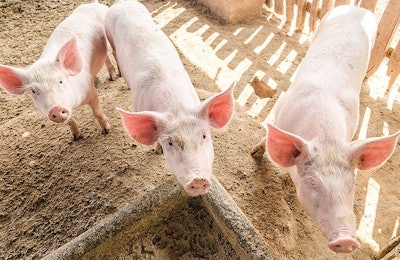
Growing demand for pig meat and increasingly efficient swine production systems will allow for growth in worldwide pig – and pig feed – production in the coming years.
The 2018 Swine Outlook report from The Food and Agriculture Organization (FAO) of the United Nations looks at the demand for pork in growth markets, its impact on feed production and explore the future of the world's No. 1 protein.
Pork industry drivers
The FAO says that, in developing countries – where most of the world's population increases take place – meat consumption has increased 5 to 6 percent per year over the past few decades.
“When an economy is growing and incomes are growing, people tend to eat more meat,” says Steve Meyer, an economist with Kerns and Associates. “Generally, if you find the parts of the world where you see increases in the standard of living, you’re going to see more meat consumption — and pork is going to be along for the ride.”
According to the FAO, world pig meat consumption in 2015 was 15.3 kg per capita; it is expected to fall slightly by 2030 to 15.1 kg per capita.
In the United States, for example, pork consumption has increased by 8.17 percent since 2010, reports Patrick Fleming, director of market intelligence for the National Pork Board, a U.S. Department of Agriculture (USDA) marketing group.
“We’re going to produce more [pork], we’re going to have more opportunity to sell more and, right now, customers are willing to buy more,” Fleming says, noting demand of the growing global middle class. "Pork has a key role to play in the consumer mind and therefore, we have this relevance across the day, which is unique to pork in a lot of ways — breakfast, lunch and dinner all have pork components.”
As pork consumption grows, so does pig feed production.

In 2015, the U.S. slaughtered more pork than ever in the last decade.
Pig feed production
WATT Global Media's 2017 World Feed Panorama of 2016 data, which looks at compound feed production worldwide, shows pig compound feed production taking 27 percent of the global market — up 0.5 percent from 2015.
According to Alltech’s 2018 Global Feed Survey, pig feed production was up 5.5 percent in 2017 over the previous year. Swine feed production is also up among the world's largest pork producers: China, European Union and the United States, respectively. (See table)

Although still the top producer, China's pork production is projected to be slightly lower in 2017 than in 2016, while most all other major producing countries are projected to increase production in 2017.
China’s pig feed production increased 11 percent in 2017, driven by the country’s move toward larger, more efficient pig farms, Alltech reports.
The European Feed Manufacturers' Federation (FEFAC) reports that Europe produced 23.6 million metric tons (mmt) of pork in 2016. Conversely, 32.2 percent of its total compound feed production (156.5 mmt) was fed to swine (50.3 mmt).
In the United States, hogs consumed approximately 46.3 mmt of feed in 2016 – 19.6 percent of the 236.3 mmt total, according to IFEEDER’s “2016 U.S. Animal Food Consumption Report."
“We’ve expanded the U.S. slaughter capacity, anticipating the larger swine herd domestically — and more pigs means more consumption of feed,” the National Pork Board’s Fleming says. “The pork industry will be using more this year and next year and for the foreseeable future.”
Other markets also saw an increase. In Russia, feed production for all species, including pigs, rose by 19 percent, and pig feed production in Africa – the region with the highest feed costs – was up 6 percent in 2017.
Feed costs tax production
Worldwide pig feed production is up about 5.54 percent, Alltech reports, with pig finisher diets is estimated to average around $363.
Sources suggest abundant grain supply will help producers with feed prices in the near term.
“Swine and poultry operations will benefit from excess supply of coarse grains and other grains,” says FAO economist, Upali GalketiAratchilage.“With the higher supply that we expect … prices are so competitive, so producers can benefit from cheaper prices of feed as well as availability. Making feed available will increase not only availability but also affordable prices for small-scale producers in particular … and will create a lot of demand for feed supplies.”
In China, the average price of feed increased each year from 2000 to 2014 before falling slightly in 2015. Rising feed prices contribute to rising hog prices but, from 2012 to 2014, hog prices fell each year while feed prices continued to rise. However, China’s feed ingredient prices are much higher than in the United States: From 2000 to 2015, China’s price of soybean meal was consistently 20 to 40 percent higher than in the United States, the U.S. Department of Agriculture (USDA) Economic Research Service (ERS) reports.
In the United States and China particularly, pig producers are seeing improvements in feed conversion ratios, due to larger, more efficient production systems and pig diets that contribute to more rapid weight gain.
Will poultry beat out pork?
According to the National Pork Board, 110.58 mmt of pork was consumed worldwide in 2017, compared with 88.14 mmt of chicken and 59.36 mmt of beef.
Pork is "still the No. 1 protein worldwide,” Fleming says. “If we keep expanding and the countries around the world keep expanding, it’ll be hard for poultry to replace pork as the No. 1 protein.”
As long as pork remains the most consumed meat in China, it will remain the most consumed meat in the world.
Meyer agrees: “Worldwide, pork is still the most consumed meat in the world, with 42 to 43 percent of the total. Anytime you win China, you’re No. 1 and pork is clearly the No. 1 meat in China.”
However, Alltech states broiler feed production overtook swine feed production in 2017 and it predicts that, by 2022, broiler meat will be the world’s most widely consumed protein.
“I think chicken will eventually catch it, but I don’t see that happening in the next 8 or 10 years. There’s a pretty sizeable gap there,” Meyer says. “Chicken is a very inexpensive product to produce and, unlike pork, doesn’t have any religious connotations to it. So, you’ve got the entire Muslim and Jewish world that is available to chicken that isn’t available to pork.”

















